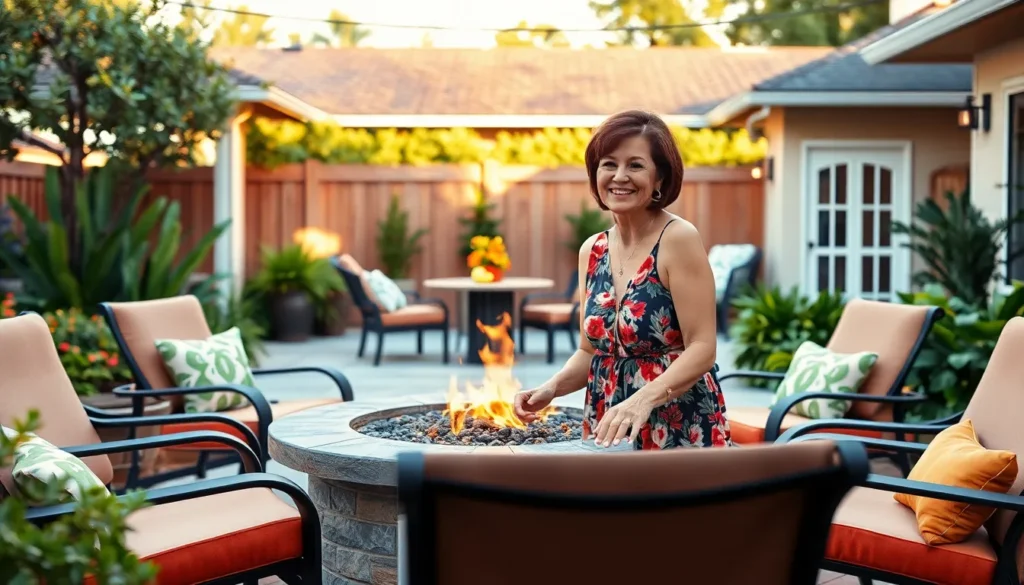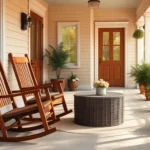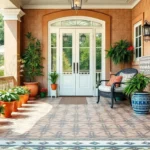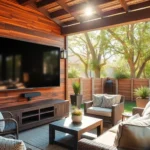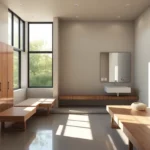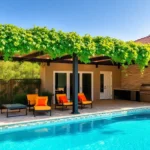We’ve all dreamed of that perfect outdoor space where we can unwind after a long day or host memorable gatherings with friends and family. Whether you’re working with a sprawling backyard or a cozy urban balcony, the right deck or patio design can transform your outdoor area into a stunning extension of your home.
Creating an outdoor oasis doesn’t have to expensive or require professional expertise. With clever planning and creative design choices, we can help you maximize your space while reflecting your personal style. From rustic wooden decks that blend seamlessly with nature to sleek modern patios featuring contemporary materials, the possibilities are endless.
We’ll explore innovative design answers that work for every budget, lifestyle, and space constraint. Get ready to discover inspiring ideas that’ll make your neighbors envious and turn your backyard into the ultimate retreat you’ve always wanted.
Create a Multi-Level Deck Design for Maximum Entertainment Space
Multi-level decks transform outdoor spaces into ever-changing entertainment hubs that maximize every square foot of your backyard. We can create distinct areas for dining, lounging, and cooking by building platforms at varying heights.
Add Built-in Seating and Storage Answers
Built-in seating eliminates the need for bulky outdoor furniture while providing hidden storage compartments underneath. We recommend incorporating bench seating along deck railings with lift-up tops that store cushions, grilling tools, or pool equipment. Corner benches create intimate conversation areas and can house up to 15 cubic feet of storage space per section.
L-shaped seating arrangements work exceptionally well on upper deck levels where guests can enjoy elevated views. Built-in planters double as backrest supports for benches while adding natural greenery to your entertainment space. Storage cubbies integrated into stair risers provide additional space for outdoor games, cleaning supplies, or seasonal decorations.
Install Outdoor Kitchen Components
Outdoor kitchens on dedicated deck levels create seamless cooking and entertaining experiences for hosts and guests. We suggest positioning grills, prep stations, and refrigeration units on the main entertainment level for easy access during gatherings. Built-in countertops made from weather-resistant materials like granite or concrete provide 8 to 12 feet of workspace for food preparation.
Installing a sink with running water eliminates trips back to the indoor kitchen during meal preparation. Overhead pergolas or roof structures protect cooking areas from weather while creating defined kitchen zones. Under-counter storage cabinets keep cooking utensils, seasonings, and serving dishes organized and easily accessible.
Design Separate Zones for Different Activities
Activity zones on different deck levels allow multiple entertainment options to occur simultaneously without interference. We create quiet reading nooks on upper levels while positioning active areas like hot tubs or fire pits on lower platforms. Dining zones work best on mid-level sections where guests can easily move between cooking and eating areas.
Privacy screens or decorative railings help define each zone while maintaining visual flow throughout the multi-level design. Lower levels accommodate larger furniture pieces like outdoor sectionals or dining sets that seat 6 to 8 people. Upper deck sections provide perfect spots for intimate seating arrangements, bar-height tables, or meditation spaces that take advantage of elevated views.
Build a Fire Pit Patio as Your Backyard Focal Point
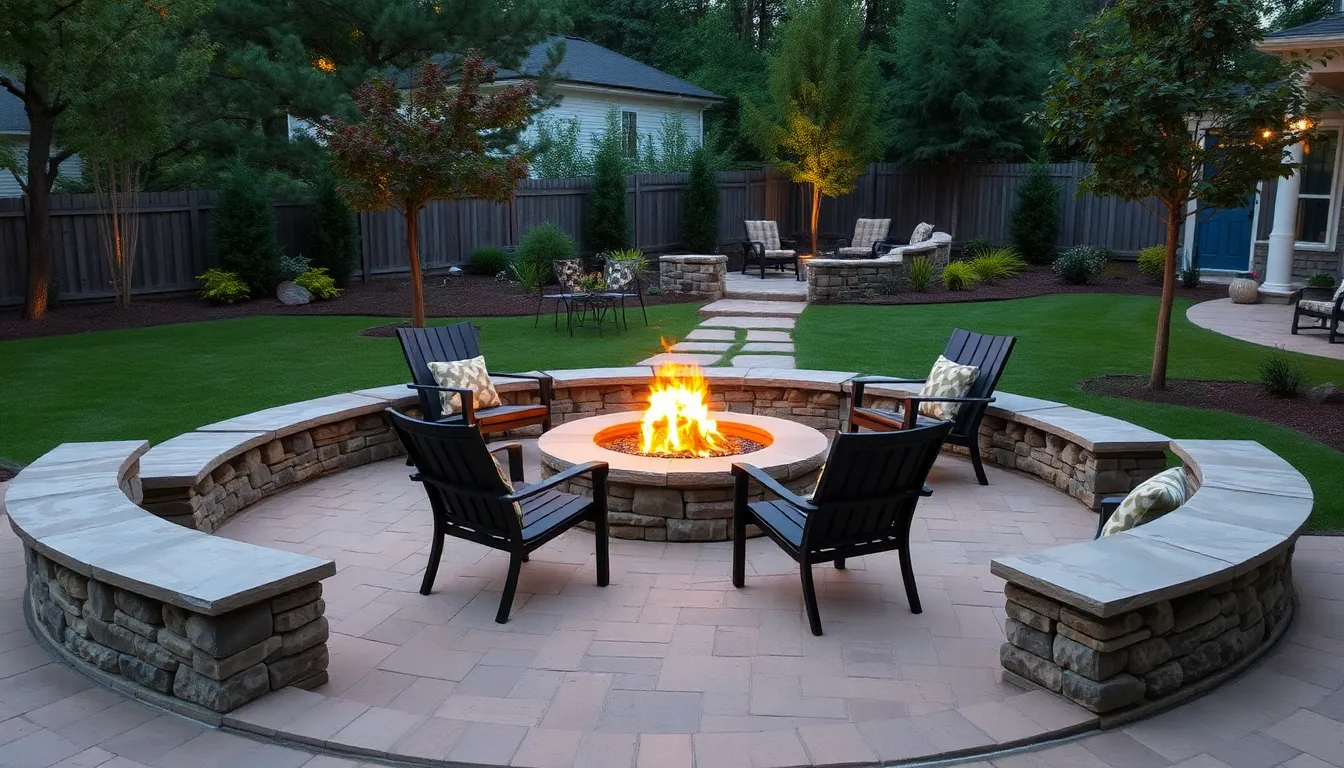
Creating a fire pit patio transforms any outdoor space into a natural gathering spot that draws people together. This backyard centerpiece enhances your home’s ambiance while providing the perfect setting for memorable evenings with family and friends.
Choose Between Gas and Wood-Burning Options
Gas fire pits offer unmatched convenience with easy ignition systems and cleaner burning capabilities. We recommend these for homeowners who prioritize quick setup and minimal maintenance in their outdoor entertainment areas.
Wood-burning fire pits deliver an authentic rustic experience complete with crackling sounds and traditional campfire aromas. These options work best when you want to create that classic outdoor atmosphere and don’t mind the extra effort of sourcing and storing firewood.
Installation considerations vary significantly between the two fuel types. Gas models require professional installation for safety compliance with local codes. Wood-burning alternatives typically allow for easier DIY installation with proper safety precautions.
Select Heat-Resistant Materials for Safety
Natural stone provides excellent heat resistance while creating an elegant foundation for your fire pit area. Materials like flagstone or granite naturally withstand high temperatures and complement various architectural styles.
Concrete pavers offer durability and design flexibility at budget-friendly price points. These fire-rated materials come in multiple colors and patterns to match your existing outdoor décor.
Fire-rated bricks deliver traditional appeal with proven safety records around open flames. We suggest using these materials within a 3-foot radius around your fire pit to prevent heat damage and ensure long-term durability.
Heat-resistant mortar becomes essential when assembling any masonry fire pit structure. This specialized product prevents cracking and maintains structural integrity under extreme temperature changes.
Plan Comfortable Seating Arrangements Around the Fire
Circular seating layouts encourage natural conversation flow while ensuring everyone receives equal warmth from the flames. Position chairs or benches approximately 6-8 feet from the fire pit edge for optimal comfort and safety.
Built-in stone benches maximize seating capacity without cluttering your patio space. These permanent fixtures can incorporate storage compartments underneath for cushions and outdoor accessories.
Weather-resistant outdoor furniture with removable cushions provides flexibility for different group sizes and occasions. Choose materials like teak or powder-coated aluminum that withstand seasonal weather changes.
Semi-circular arrangements work perfectly for smaller patios or when you want to maintain views of other industry features. This layout still promotes social interaction while accommodating space limitations effectively.
Design a Pergola-Covered Outdoor Living Room
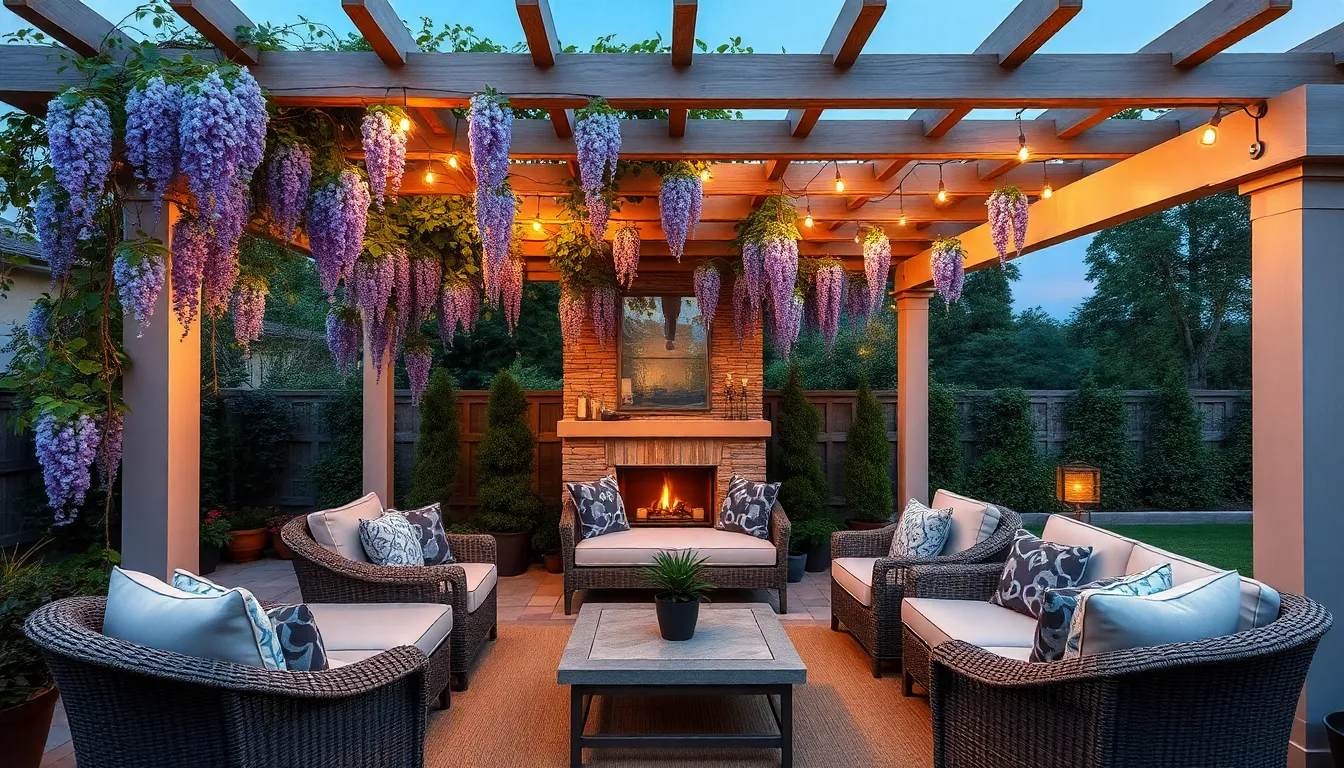
Creating a pergola above your deck or patio transforms the space into an inviting outdoor living room that seamlessly blends shelter with openness. This structural addition defines your outdoor area visually while providing the perfect framework for additional design elements.
Select Weather-Resistant Furniture and Fabrics
Choosing furniture specifically designed for outdoor use ensures your pergola space remains comfortable throughout all seasons. Teak, powder-coated aluminum, and synthetic wicker materials resist moisture, sun damage, and mildew effectively, making them ideal investments for your outdoor living room.
Pairing durable furniture with the right fabrics elevates both comfort and longevity. Solution-dyed acrylic and polyester cushions offer UV resistance and quick-drying properties that maintain their appearance and comfort even after rain or extended sun exposure.
Weather-resistant combinations allow you to leave furniture outside year-round without constant maintenance or storage concerns. These materials maintain their structural integrity while providing the comfort needed for extended outdoor relaxation and entertaining.
Add Climbing Plants for Natural Shade
Incorporating climbing plants like wisteria, grapevine, jasmine, or clematis around your pergola creates natural shade that cools the space while adding lush, green aesthetics. These vertical growing plants provide living canopy coverage that changes with the seasons.
Climbing vegetation attracts pollinators and helps soften hard architectural lines, making your outdoor living area feel more serene and connected to nature. Plants create a natural cooling effect that can reduce temperatures by several degrees compared to uncovered areas.
Selecting the right climbing plants for your climate ensures year-round beauty and functionality. Fast-growing varieties like clematis provide quick coverage, while slower-growing options like wisteria offer long-term structural beauty and substantial shade.
Install Outdoor Lighting for Evening Ambiance
Using layered outdoor lighting extends your pergola space’s usability well into the evening hours. String lights draped over pergola beams, combined with wall sconces, lanterns, and pathway lights, create soft, welcoming illumination that transforms the atmosphere.
Warm LED bulbs generate a cozy atmosphere while consuming less energy than traditional lighting options. Strategic placement of different light sources highlights architectural features and landscaping elements that make your outdoor living space more inviting after dark.
Lighting also enhances safety by illuminating walkways and seating areas, preventing accidents while allowing you to enjoy your pergola-covered space throughout the night. Dimmer controls and smart lighting systems provide customizable ambiance for different occasions and moods.
Construct a Pool Deck with Integrated Lounging Areas
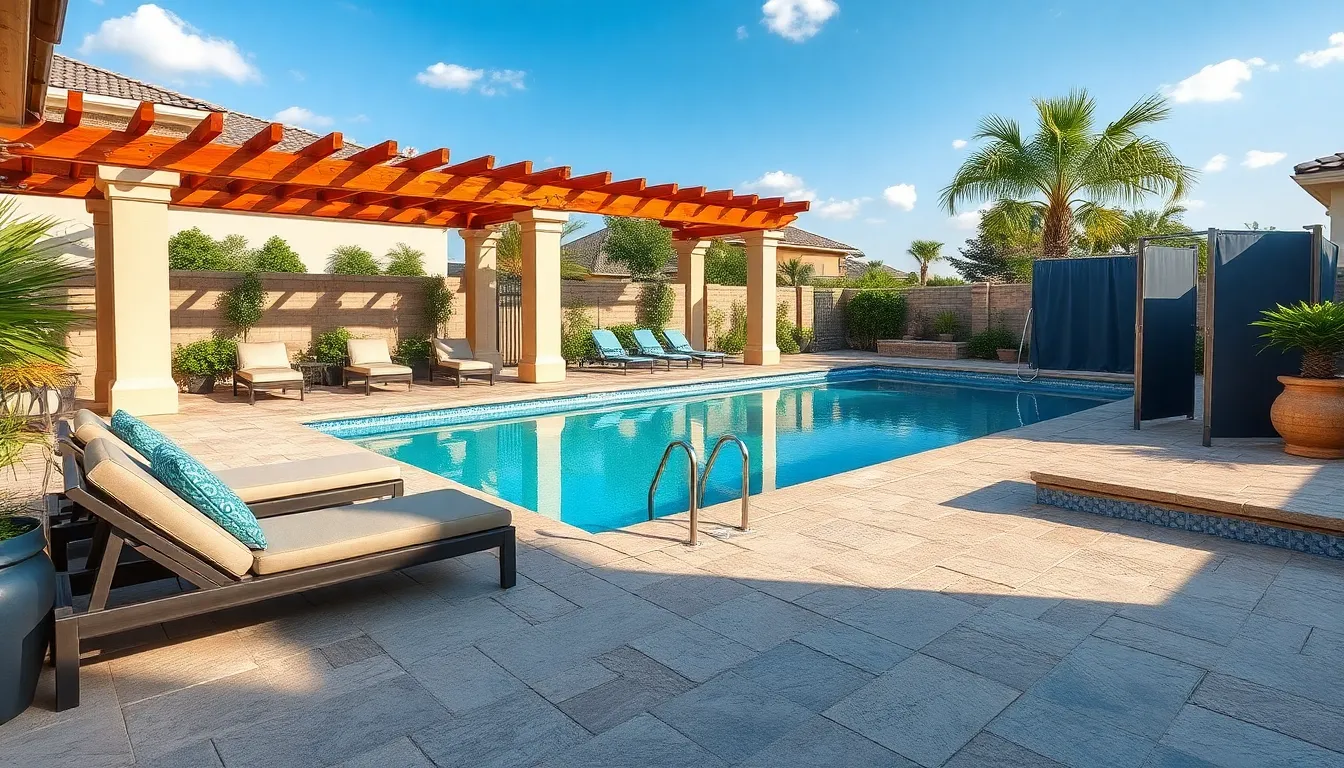
Building on the concept of creating distinct outdoor zones, we can design a pool deck that seamlessly integrates comfort with functionality. This approach transforms your pool area into a comprehensive entertainment space that rivals any indoor living room.
Use Non-Slip Materials for Wet Areas
Safety becomes our top priority when designing surfaces around water features. We recommend selecting textured concrete, roughened stone tiles, or specially treated composite decking to maintain traction even when wet. These materials significantly reduce accident risks while preserving the aesthetic appeal of your pool deck.
Composite decking offers exceptional durability and requires minimal maintenance compared to traditional wood options. Stone tiles provide a luxurious appearance while delivering superior grip in wet conditions. Textured concrete allows for customizable finishes that complement your home’s architectural style while ensuring maximum safety for swimmers and loungers alike.
Create Shade Structures for Sun Protection
Protecting our guests from excessive sun exposure requires strategic placement of shade elements throughout the pool deck area. We can incorporate pergolas with adjustable slats that allow us to control the amount of sunlight filtering through. Retractable awnings provide flexible coverage that adapts to changing weather conditions and sun angles throughout the day.
Shade sails offer a modern aesthetic while delivering effective UV protection across large areas of the deck. Gazebos and umbrellas create intimate spaces for relaxation and conversation. These structures not only provide essential sun relief but also define separate zones within the larger pool deck environment, creating visual interest and functional variety.
Add Outdoor Shower and Changing Stations
Outdoor shower installations enhance the functionality of our pool deck by providing convenient rinsing stations for swimmers. We position these features near the pool or house where plumbing access is readily available. Dual shower heads, including both rain and handheld options, accommodate different user preferences and washing needs.
Privacy enclosures using PVC posts and decking materials create secluded changing areas that maintain modesty while preserving the open feel of the outdoor space. DIY installation involves careful planning of layout, ensuring compliance with local building codes, and setting up proper plumbing and drainage systems.
Prefabricated shower kits simplify the installation process and reduce both time and costs associated with custom builds. Modular enclosures offer flexibility in design while maintaining professional appearance standards. Some configurations incorporate dedicated changing rooms that provide additional convenience for families and frequent pool users.
Install a Rooftop Deck for Urban Outdoor Living
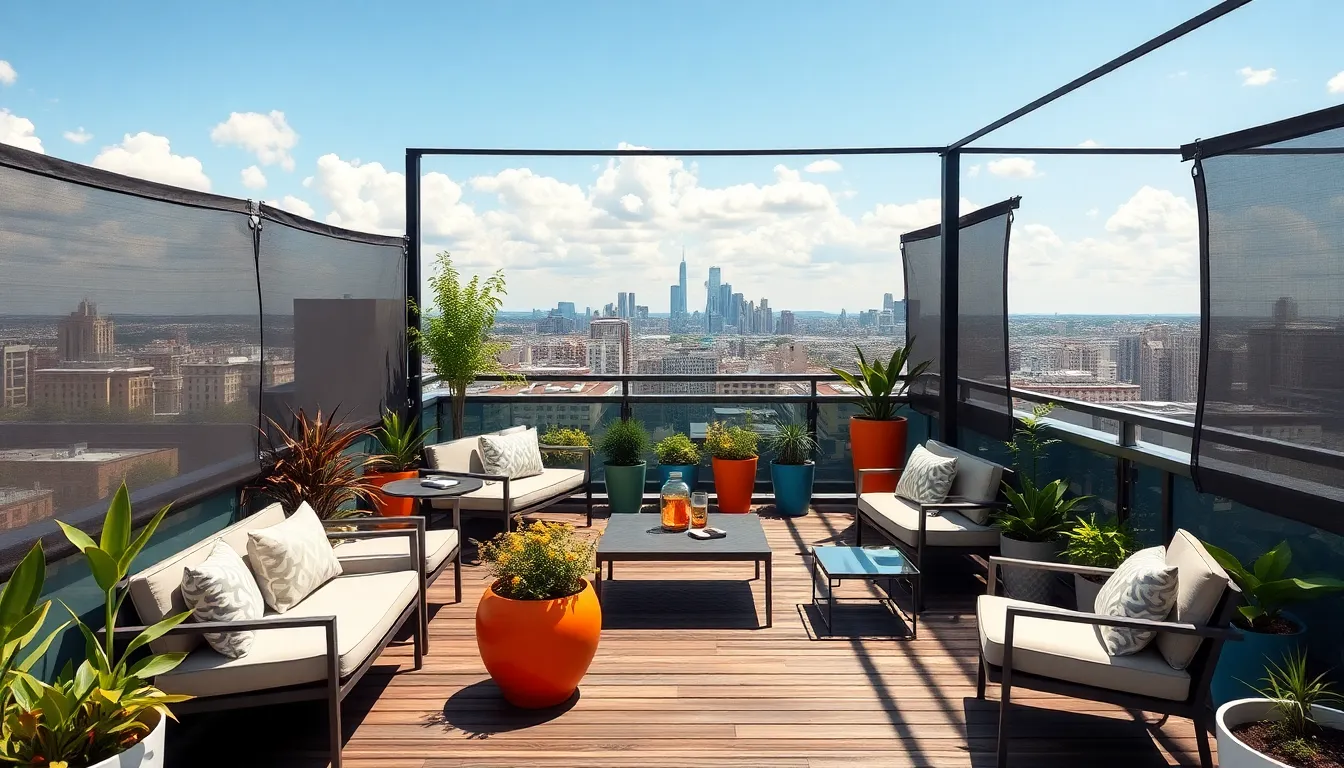
Rooftop decks maximize outdoor space in urban environments, offering a retreat with spectacular views and fresh air. These elevated spaces can transform unused rooftop areas into functional outdoor living extensions that rival traditional ground-level patios.
Consider Weight Limitations and Structural Support
Structural assessment is crucial before installing any rooftop deck since buildings have exact weight limits. We recommend consulting a structural engineer to evaluate your building’s load capacity and determine safe installation parameters.
Lightweight materials reduce structural burden while maintaining durability and aesthetic appeal. Composite decking and wood alternatives like Garapa decking provide excellent options that won’t compromise your building’s integrity. Garapa naturally resists weathering without requiring staining, making it ideal for both small residential and commercial rooftop installations.
Construction methods matter when minimizing added weight to existing structures. We suggest using pedestal systems or lightweight framing techniques that distribute loads evenly across the rooftop surface. These methods ensure safety while creating stable foundations for your urban outdoor retreat.
Plan for Wind Protection and Privacy Screens
Wind resistance becomes essential at rooftop heights where gusts can disrupt comfort and damage furnishings. Strategic placement of glass panels, lattice screens, or tall planters creates effective windbreaks that shield seating areas without obstructing panoramic views.
Privacy screens enhance intimacy while blocking sightlines from neighboring buildings. Materials like wood, metal, or fabric can create secluded spaces that feel more private and comfortable. Solid railings serve dual purposes by reducing both wind exposure and visual intrusion from surrounding structures.
Noise reduction benefits come from well-designed privacy features that block sound transmission. These barriers create quieter environments for relaxation and conversation, making your rooftop deck feel more like a peaceful sanctuary than an exposed urban space.
Choose Lightweight Furniture and Planters
Aluminum and resin furniture comply with rooftop weight constraints while providing durability and style. Synthetic wicker offers weather resistance and visual appeal without the bulk of traditional materials. We recommend selecting pieces that balance functionality with weight considerations.
Modular and foldable options provide flexibility for different occasions and seasonal storage needs. These versatile pieces allow you to reconfigure your space layout while maintaining compliance with structural limitations.
Lightweight planters made from composites or fabric accommodate healthy plant growth without exceeding weight limits. These containers can hold sufficient soil for thriving greenery while contributing to the overall aesthetic of your rooftop space. Combining plants with efficient furnishings maximizes both usability and visual impact of your urban outdoor living area.
Multifunctional benches serve dual purposes as seating and planters, creating built-in features that enhance visual interest while serving practical needs. These space-saving answers work particularly well in smaller rooftop installations where every square foot counts.
Build a Ground-Level Patio with Natural Stone Elements
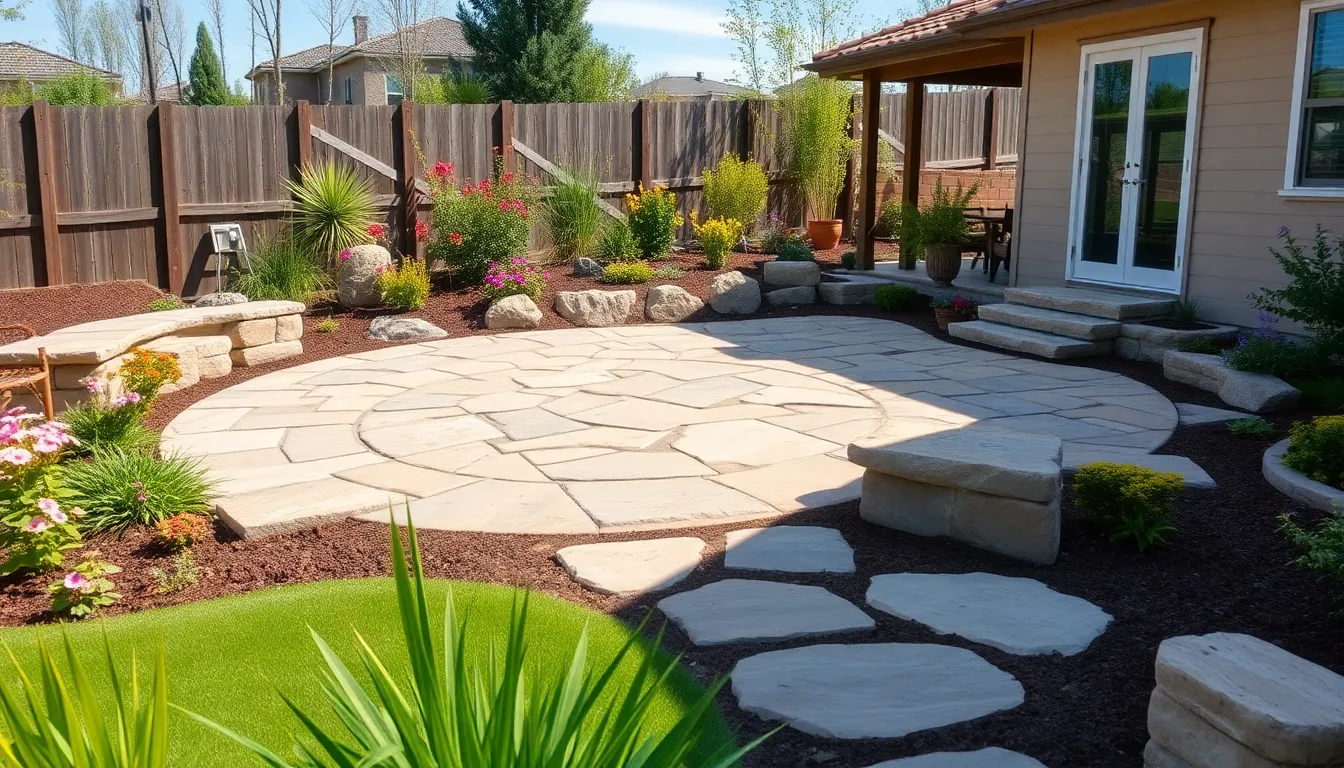
Ground-level patios offer an accessible and cost-effective way to expand your outdoor living space while maintaining a seamless connection to your home. We’ll explore how natural stone elements can transform your patio into a durable and visually stunning outdoor retreat.
Select Durable Stone Materials for Your Climate
Climate considerations should drive your stone selection process to ensure long-lasting beauty and functionality. Dense stones like granite and bluestone excel in wet or freeze-thaw environments because they resist cracking and weather damage. We recommend these materials for regions experiencing harsh winters or frequent precipitation.
Hot and dry climates present different challenges that require exact stone choices. Sandstone and limestone work well in these conditions, though you’ll need to consider their porosity levels and ongoing maintenance requirements. Dense materials generally outperform porous options when it comes to durability and weather resistance.
Traffic patterns and usage intensity also influence material selection beyond climate factors. Stones that withstand heavy foot traffic while maintaining their appearance include flagstone, slate, and bluestone, which offer natural textures and colors that complement outdoor surroundings. We suggest evaluating both aesthetic preferences and practical durability when making your final stone choice.
Design Proper Drainage Systems
Water management forms the foundation of any successful stone patio installation. Install a slight slope of 1-2% away from your home to ensure proper runoff and prevent water accumulation against your foundation. This grade prevents pooling while remaining virtually unnoticeable to users.
Gravel bases beneath stone surfaces help water seepage and provide structural stability. We recommend installing adequate drainage channels or French drains in areas where natural drainage presents challenges. These systems protect stone integrity and prevent structural issues that could compromise your patio’s safety and functionality.
Professional assessment may be necessary for properties with complex drainage challenges or clay soil conditions. Proper drainage preserves your investment by preventing frost damage, stone shifting, and water-related deterioration that could require costly repairs.
Incorporate Native Plants in Landscaping
Native plant integration enhances both the natural beauty and ecological value of your stone patio space. These plants require less water and maintenance due to their adaptation to local climate conditions, making them ideal companions for low-maintenance stone installations. We find that native grasses, shrubs, and perennials create beautiful transitions between hardscape and natural areas.
Biodiversity benefits extend beyond aesthetics when you choose plants that provide habitat for pollinators and local wildlife. Consider surrounding your patio with native species that soften stone edges while creating a harmonious outdoor environment. These plantings also help with natural drainage and erosion control around patio perimeters.
Seasonal interest becomes more achievable with native plant selections that bloom and change throughout the year. We recommend consulting local extension services or native plant societies to identify the best species for your exact region and stone patio design goals.
Create an Outdoor Dining Space with Kitchen Features
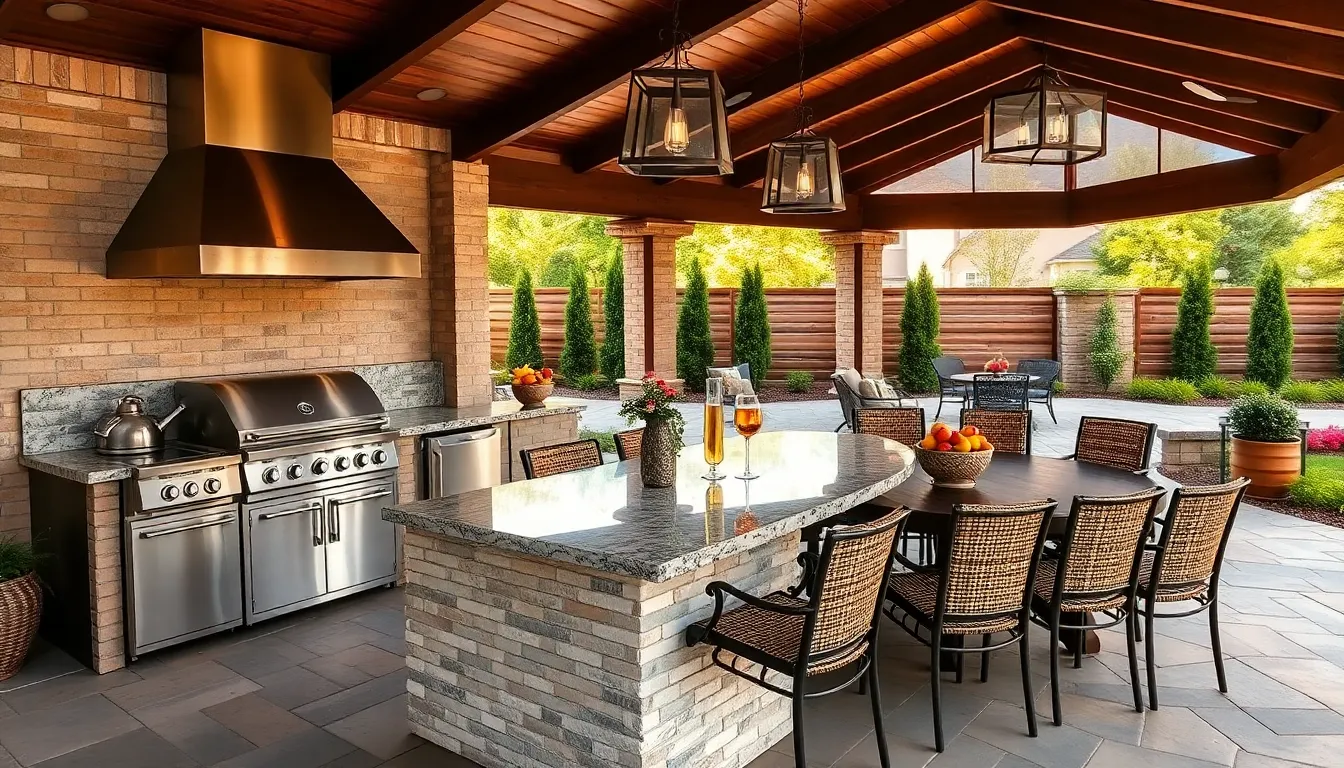
Building on our exploration of distinct outdoor zones, we can transform any deck or patio into a functional culinary haven that rivals indoor kitchens. Outdoor dining spaces with integrated kitchen features extend our living areas while creating the perfect setting for memorable gatherings.
Install Weather-Proof Appliances and Storage
Outdoor-rated stainless steel appliances form the foundation of any successful outdoor kitchen, designed specifically to withstand moisture, temperature changes, and UV exposure. We recommend investing in a high-quality grill as the centerpiece, complemented by weather-resistant refrigerators and sinks that maintain functionality year-round. Custom cabinetry built with marine-grade polymer or sealed wood finishes provides durable storage answers that protect cookware and supplies from the elements.
Covering our outdoor kitchen with a roof or pergola enables year-round use while protecting expensive appliances from harsh weather conditions. Bar areas and self-serve drink stations complement the cooking zone beautifully, improving our entertaining capabilities. Consider functional layouts like in-the-round kitchens with circular deck inlays to create striking focal points while providing social seating around the cooking area.
Plan for Adequate Counter Space and Prep Areas
Ample countertop space using materials like granite, concrete, or durable composite decking surfaces allows for efficient food preparation and elegant serving presentations. We position prep zones directly adjacent to cooking appliances to create smooth workflow during meal preparation, reducing steps and increasing efficiency. Bi-level or multi-zone decks help us delineate cooking, dining, and relaxing spaces effectively while maintaining visual cohesion.
Strategic placement of prep areas ensures we have dedicated spaces for chopping, mixing, and plating without overcrowding the main cooking zone. Multiple work surfaces accommodate larger gatherings where several people might assist with meal preparation simultaneously.
Add Dining Furniture for Various Group Sizes
Versatile dining furniture accommodates everything from intimate couples’ dinners to large family gatherings, making modular or extendable tables ideal choices for patios and decks. Built-in bench seating around kitchen islands or circular seating arrangements maximizes space utilization while encouraging conversation around meals. Weather-resistant materials like treated wood, aluminum, or synthetic rattan paired with comfortable outdoor cushions ensure durability without sacrificing style.
Flexible seating arrangements allow us to reconfigure our outdoor dining space based on guest count and occasion type. Consider combining fixed seating elements with moveable chairs to create the perfect balance of permanence and adaptability for any outdoor entertainment scenario.
Design a Zen Garden Patio for Relaxation and Meditation
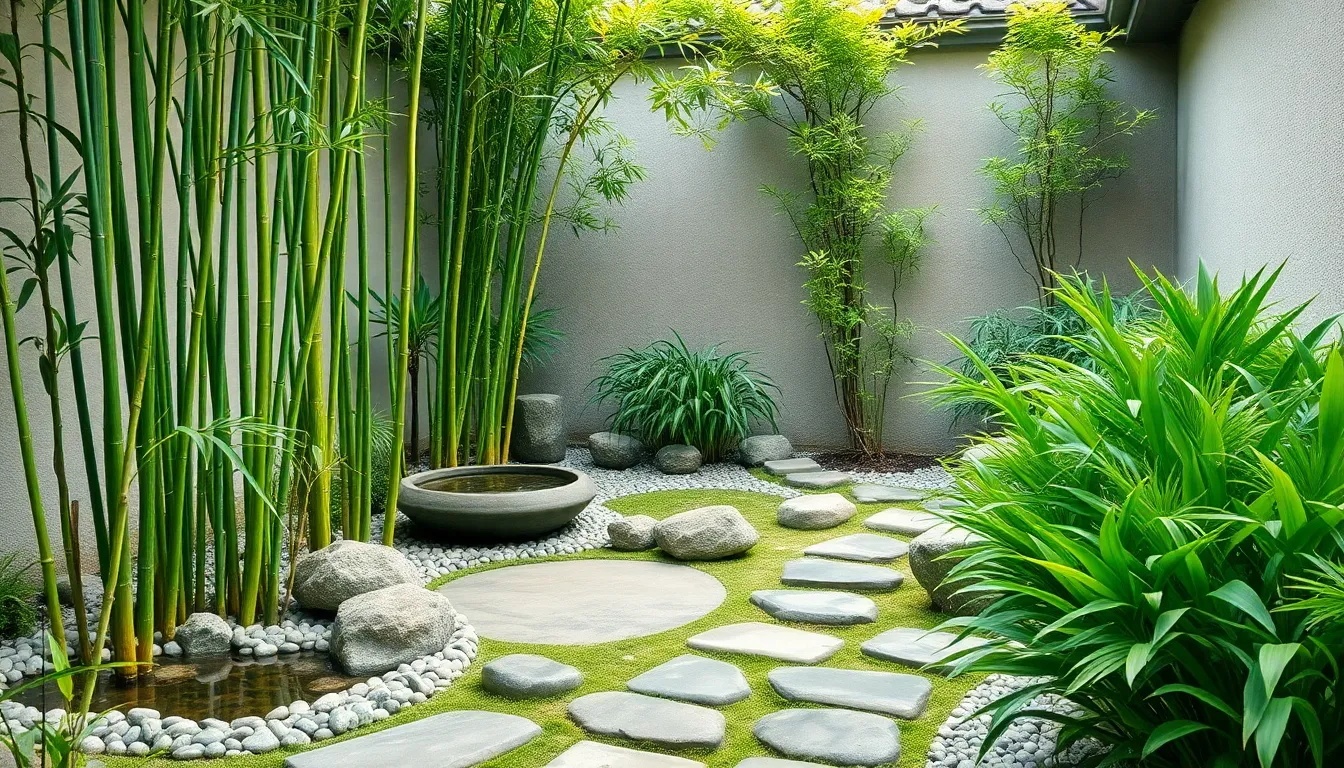
Transitioning from outdoor dining spaces, we can create a completely different atmosphere by designing a Zen garden patio that focuses on tranquility and mindfulness. Traditional Japanese garden principles combined with modern touches transform your outdoor space into a peaceful retreat for meditation and relaxation.
Choose Calming Materials Like Bamboo and Water Features
Bamboo serves as a classic tranquil material that brings natural appearance and soothing qualities to any Zen garden design. We recommend incorporating this versatile plant as screening, decorative accents, or even as structural elements for privacy panels. Water features add a peaceful soundscape that enhances relaxation through gentle bubbling fountains or koi ponds with river rocks and mini waterfalls. Though traditional Zen gardens typically don’t include water elements, modern interpretations embrace these features for their meditative sound qualities. Natural materials like river stones, smooth pebbles, and weathered wood complement bamboo installations perfectly. Stone lanterns provide subtle industry lighting that creates ambiance during twilight hours while maintaining the authentic aesthetic.
Create Pathways with Natural Stepping Stones
Natural stone pathways guide visitors through your garden while encouraging mindful walking and contemplation. We suggest using gravel to create raked or patterned surfaces that are visually calming and meditative in nature. Stepping stones lead guests along deliberate routes that promote slower movement and deeper awareness of surroundings. Gravel requires minimal maintenance while offering opportunities for creating geometric patterns or flowing designs that symbolize water movement. Rough textures from natural stones contrast beautifully with smooth pebbles to provide visual interest and tactile variety throughout the pathway system. Floating decks or designated meditation platforms enhance the usability of pathways by creating stopping points for mindfulness activities.
Plant Low-Maintenance Greenery for Peaceful Atmosphere
Low maintenance plants create serene environments without requiring extensive upkeep that disrupts the peaceful garden atmosphere. We recommend selecting bonsai trees, Japanese maples, moss, ferns, and creeping ground covers that thrive with minimal intervention. Japanese maples add seasonal beauty while symbolizing concepts like transience and natural cycles that align with Zen philosophy. Cherry trees provide spring blossoms that embody the fleeting nature of beauty central to Japanese aesthetics. Bamboo plantings serve dual purposes as both screening elements and peaceful rustling sounds when breezes move through the leaves. Ground covers like moss and creeping varieties soften hardscape elements while requiring little water or maintenance care.
Build a Deck Extension That Connects Indoor and Outdoor Spaces
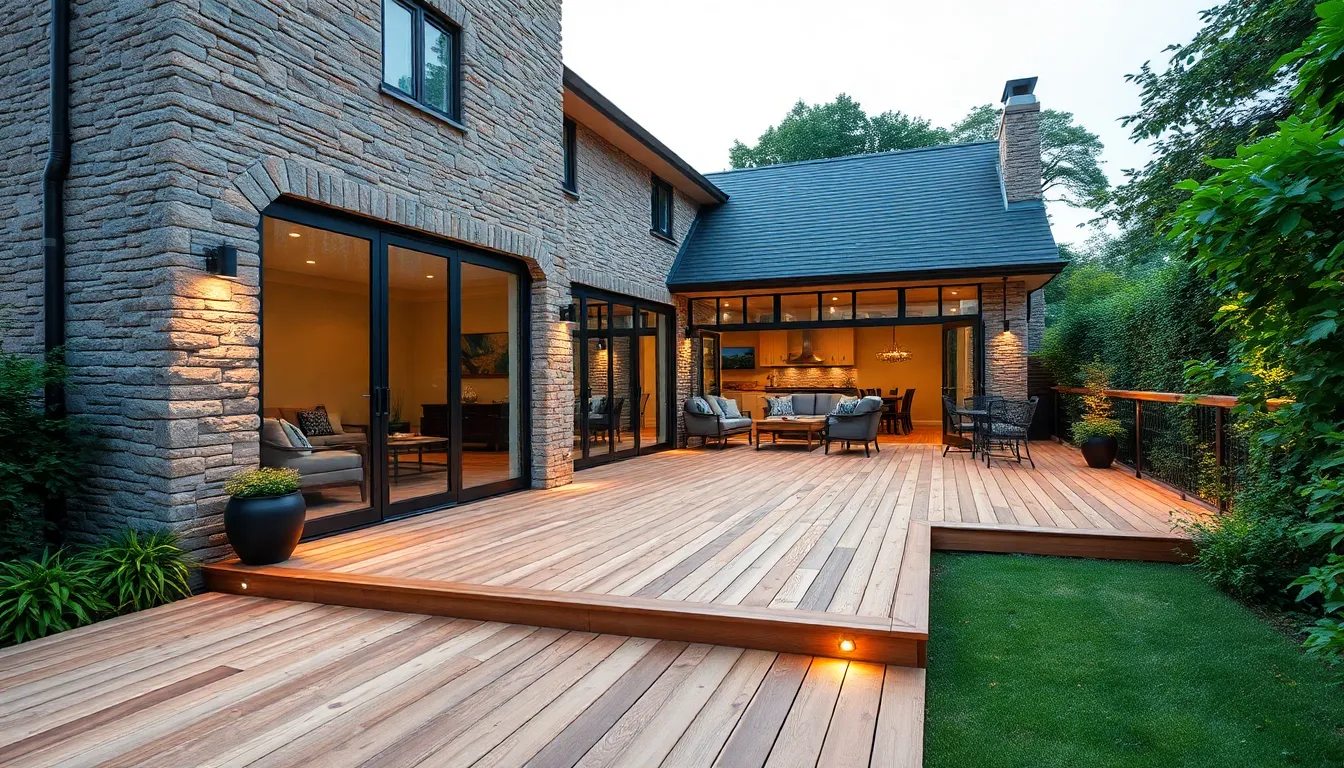
Creating a deck extension transforms your home’s connection to the outdoors by establishing natural flow between interior and exterior spaces. Multi-level decks with stairs and built-in lighting add depth and function, making them ideal for entertaining and casual gatherings.
Match Materials to Your Home’s Existing Architecture
Visual harmony begins when we select decking materials that complement our home’s existing style and structure. Wood decking paired with brick or stone exteriors creates a cohesive aesthetic that feels intentionally designed rather than added as an afterthought. Modern homes benefit from sleek metal or glass elements integrated into deck railings that echo window frames and architectural lines.
Composite materials offer versatility in matching various home styles while providing durability against weather elements. Stone accents can bridge the gap between natural landscapes and contemporary home designs. Color coordination between exterior paint, roofing materials, and deck finishes ensures the extension appears as a natural part of the original structure rather than a separate addition.
Install Large Sliding Doors for Seamless Transition
Large sliding or folding glass doors eliminate barriers between indoor and outdoor living spaces by providing unobstructed views and easy access. These door systems maximize natural light penetration into interior rooms while facilitating airflow throughout the connected spaces. Living and dining areas benefit most from this integration since they naturally extend outdoor entertaining functions.
Accordion-style folding doors create the most dramatic opening when fully retracted, essentially removing the wall between spaces entirely. Floor-to-ceiling glass panels maintain visual connection even when closed, allowing us to enjoy outdoor views year-round. Weather stripping and quality hardware ensure these large door systems maintain energy efficiency while providing smooth operation for daily use.
Plan Consistent Flooring Between Interior and Exterior
Flooring continuity creates the strongest visual bridge between indoor and outdoor spaces by eliminating transition breaks that interrupt natural flow. Wood-look composite decking closely resembles indoor hardwood floors, creating seamless transitions that make deck areas feel like extended interior rooms. Porcelain tiles designed for outdoor use can match interior stone or ceramic flooring while providing weather resistance.
Threshold details require careful planning to manage height differences between interior and exterior floor levels. Gradual transitions using matching materials prevent tripping hazards while maintaining visual continuity. Color matching becomes crucial when using different materials, as slight variations can create jarring interruptions in the intended seamless effect.
Conclusion
We’ve explored countless ways to transform your outdoor space into a stunning extension of your home. From multi-level entertainment decks to tranquil Zen garden patios each design concept offers unique opportunities to express your personal style while maximizing functionality.
The key to success lies in choosing elements that work within your budget space constraints and lifestyle needs. Whether you’re drawn to a rooftop retreat with city views or a ground-level stone patio surrounded by native plants the possibilities are truly endless.
Now it’s time to take action and bring these ideas to life. Start with one focal point that excites you most and build from there. Your dream outdoor space is waiting to become reality.
Frequently Asked Questions
What budget do I need to transform my outdoor space?
You don’t need a significant expense to create a beautiful outdoor space. The article emphasizes that transforming your backyard or balcony can be achieved without professional help. Focus on innovative design ideas that work within various budgets, from simple additions like outdoor lighting and plants to more substantial investments like fire pits or pergolas.
How can I maximize space in a small outdoor area?
Use multi-level designs to create distinct zones for different activities like dining, lounging, and cooking. Built-in seating provides hidden storage while saving space. Consider vertical elements like privacy screens and climbing plants. For urban balconies or small patios, choose multifunctional furniture like benches that double as planters.
What materials are best for outdoor fire pit areas?
Use heat-resistant materials like natural stone, concrete pavers, and fire-rated bricks for safety and durability. These materials can withstand high temperatures and weather conditions. Always ensure compliance with local building codes and safety regulations when installing any fire pit, whether gas or wood-burning.
Should I choose a gas or wood-burning fire pit?
Gas fire pits offer convenience with easy ignition and consistent flames, while wood-burning pits provide rustic charm and authentic campfire ambiance. Consider your local regulations, maintenance preferences, and desired atmosphere. Gas options require less cleanup but need professional installation for natural gas lines, while wood-burning pits need regular ash removal.
How do I create year-round usable outdoor spaces?
Install pergolas or roofs for weather protection, choose weather-resistant furniture and fabrics, and add layered outdoor lighting for evening use. Consider retractable awnings or shade sails for flexibility. Use materials that withstand your local climate conditions, and incorporate features like outdoor heaters for cooler seasons.
What safety considerations are important for pool decks?
Use non-slip materials such as textured concrete, roughened stone tiles, or specially treated composite decking in wet areas. Install adequate shade structures to prevent sun overexposure. Consider adding outdoor showers and changing stations for convenience. Ensure proper drainage to prevent water accumulation and slipping hazards.
Can I install a rooftop deck on any building?
Always consult with a structural engineer before rooftop deck installation to ensure your building can support the additional weight. Use lightweight materials like composite decking and consider pedestal systems that distribute weight evenly. Check local building codes and obtain necessary permits before beginning any rooftop construction project.
What plants work best for outdoor patios?
Choose native plants for your region as they require less maintenance, are better adapted to local climate conditions, and provide habitat for local wildlife. Native plants typically need less water and fertilizer, making them eco-friendly and cost-effective. Consult local nurseries or extension services for the best native species recommendations.
How do I create privacy in my outdoor space?
Use privacy screens, decorative railings, glass panels, lattice screens, or tall planters to create intimate spaces while maintaining visual flow. Climbing plants on pergolas provide natural privacy and shade. For rooftop spaces, consider windbreaks that also offer privacy. Strategic placement of these elements can define zones without blocking views entirely.
What’s the best way to connect indoor and outdoor spaces?
Install large sliding or folding glass doors to eliminate barriers between spaces and maximize natural light. Use consistent flooring materials that closely resemble indoor flooring while ensuring outdoor safety requirements. Match exterior materials to your home’s existing architecture for visual harmony and seamless transitions between interior and exterior areas.

